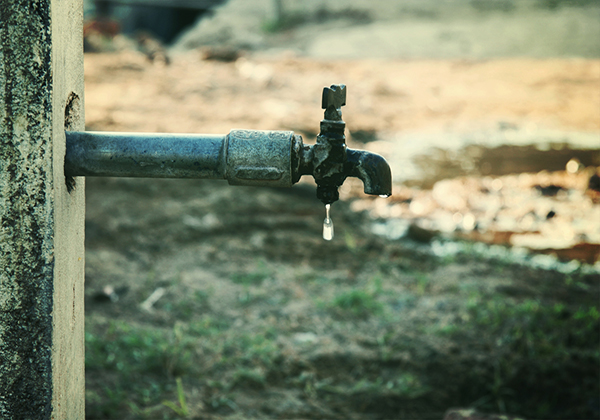In The Midst of Drought
Regardless of whether it comes through drying climate or regulating agencies, western cannabis cultivators are due for a winnowing.
After being outside in the gravel parking lot under the bright, clear skies the meeting hall looked dark and shadowy. As my eyes adjusted, I could discern a riveted crowd of cannabis farmers standing gathered around a long table on a raised dais. Only one person sat there: Casey O’Neill of the Emerald Growers Association (EGA). Young, bearded and driven, he held them rapt.
The sun is an indelible pillar of California’s mythos, but it brought these farmers together for more than one reason. The long, sunny summers which have coaxed millions of plants to the size of small trees in a single season had begun to threaten those plants’ existence. As the hot weeks have sucked the annual rainy winters dry, the state has writhed in the worst drought in recorded history. As I walked in, these concerned farmers had settled in for a reprieve in the shade. Their way of life was on the line.
As if the sun weren’t punishing enough, the press has also been merciless. The New York Times, the Washington Post and the Los Angeles Times all took their turns deriding these farmers, even going so far as to suggest that cannabis cultivation had somehow caused the drought. To anyone who believes that, the discussion led by O’Neill would have sounded quite strange. Using his pioneering research, cannabis farmers along the north coast of California were not only thriving on dwindling water supplies; they were actively helping to reverse the drought.
Inflated Figures & Depleted Rivers
The American West is in trouble. Stricken by the worst drought in a thousand years, farmers in most of the states west of the Rockies are forced to cut back on their plans as states cut back their water allotments to the lowest levels in recorded history. Cannabis farmers, who have so often been driven by the drug war to the peripheries of undeveloped watersheds, have been among the first to feel the pinch.
For better or worse, business as usual is going away – perhaps for good. Many cannabis farmers, and especially outdoor farmers, have long grown their crops with little regard to how much water they used. When a massive multi-agency raid netted 86,579 plants across the Emerald Triangle in summer 2015, law enforcement was quick to trumpet the relief to the region’s over-taxed watersheds; this operation, according to Mendocino County Sheriff Tom Allman, guzzled half a million gallons every day.
O’Neill gave the problem some historical perspective.
“Before white settlers came with their saws and grazing cows, this region was covered by old growth forest and perennial grasses which kept the topsoil aerated, deep and porous. When the rains came, the deep root structures of the old growth perennial grasses drew the rainwater deep and let the topsoil soak it in like a sponge. When the fogs came, the old growth redwood stands trapped them in their leaves and condensed them into rain, extending the cycle. That stored water helped to sustain the ecosystem during the dry months.”
He continues, “But then new settlers came in, clear-cut the old growth forests, overgrazed the really yummy perennial grasses and let the annual grasses take over, with their shallow root structures. Now when the rains come, the soil is such a shallow sponge that it can’t absorb the precipitation and washes away as runoff. And now we have a vicious cycle, because now the top soil is even shallower than before.”
It’s a systemic problem which has carried forward to the present day. As one of the nation’s main producers of vegetables, fruits and nuts, California has diverted vast lakes of freshwater out of its natural watersheds to feed a thirsty agricultural economy. Some crops consume mind-boggling quantities: the much-maligned almond, at a rate of a gallon of water per nut, is hardly the worst of the offenders. A single tomato requires three times that much. One glass of wine takes 15 gallons. One hamburger needs over 100.
Cannabis, at an estimated half-gallon per joint, is hardly causing the problem. To the contrary – according to O’Neill’s vision for the future, cannabis farmers can be a critical part of the solution.

Photo by Rita Hogan
Not the Problem – the Solution
In stark contrast to the thirsty trespass grows busted by law enforcement, EGA members show how conscious conservation can produce top-shelf bud with a minimum of irrigation. According to membership records, their growers average about 1 gallon of water per pound, per day. With a 150-day growing season, that tallies to about 150 gallons per pound, according to EGA director Hezekiah Allen – but even this is only a rough rule of thumb, since young plants just rooting need far less water than mature plants getting their autumn flush.
What is the EGA doing that’s so different? According to O’Neill, the difference is in the treatment of precious rainwater on the coast’s hilly valleys. “Every chance we get, we slow it down, let it soak in.” He uses mulch, leaves, rotting wood – anything to slow the runoff of rain, restoring it instead to deepen the topsoil layer and reverse the long-term trends which created the drought in the first place.
And cannabis is a vital part of the solution. This was recognized by federal agronomist Lyster H. Dewey over a century ago, who in a 1913 U.S. Department of Agriculture circular describing the effects of marijuana’s cousin industrial hemp, noted that it “tends to improve rather than injure the soil… hemp loosens the soil and makes it more mellow.”
Reminiscent of O’Neill’s soil improvement mantras, Dewey attributes the improvements to “the rather coarse taproots, penetrating deeply and bringing up plant food from the subsoil, [which] decay quickly after the crop is harvested and tend to loosen the soil more than do the fibrous roots of wheat, oats and similar broadcast crops.”
In the wake of the losses wreaked by the sawmills and ranchers who ravaged the West even as Dewey penned his conscientious advice, cannabis is filling the void. Farmers using best practices are restoring their ecosystems, encouraging rainwater to soak and using cannabis to restore the deep, aerated topsoil which once made the West so rich with life. Going beyond mere conservation, the region’s best growers are working to reverse the drought their forebears created.

Photo by Vinoth Chandar
Full Creeks & Bank Accounts
Those who succeed stand to be well rewarded, absent a September miracle. After years of the worst drought in recorded history, growers still following wasteful practices may or may not be able to complete their flushes late in the dry season, when 14-foot monster plants may need 15 gallons per day and many creeks will be bone dry. In recent years of drought, many northern California creeks have run dry before the end of August, and UC Berkeley researchers have noted that some regional watersheds have annual low flow levels well below the needs of nearby cannabis farms. Simply put, some western watersheds can no longer support the cannabis cultivation which has sprung up around them.
Alarmed by the drain on natural ecosystems, local governments have already provoked a backlash. The Sacramento County Board of Supervisors, relying on inflated Fish and Wildlife statistics, has gone so far as to declare all marijuana cultivation to be water waste; increasingly, state officials have begun to crack down on grows caught diverting water which isn’t rightfully theirs. Water-wasting growers are under attack from all sides.
Yet, at least some officials at Fish and Wildlife apparently know the difference between irresponsible riparian robbers and conscious cannabis cultivators. Director Charlton Bonham testified to a legislative committee that his department had made good progress working with cannabis farmers who wanted to be in compliance with the state’s tightening water allotments and that his team had already performed 100 inspections by early July 2015. As evidence of further acquiescence, the North Coast Regional Water Quality Control Board has announced new waste discharge requirements (WDR) which would, for the first time in history, regulate the water use of north coast pot growers. Farmers who attended public meetings on the issue reported a surprisingly genuine willingness to learn about their industry on the part of the water board; after taking public comments, the board is expected to finalize its permit program this fall.
Those who cannot find a sustainable relationship with their water supplies will find themselves out in the cold; those who respect the watersheds – and the agencies empowered to protect them – will watch their gardens thrive.
Do you try and conserve water in your grow? Tell us how.
Originally published in issue 17 of Cannabis Now. LEARN MORE






















